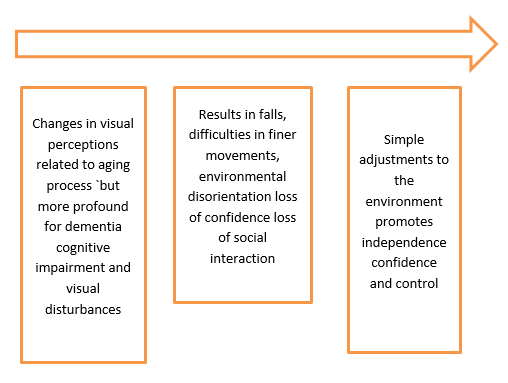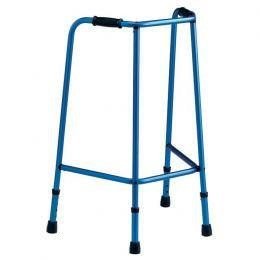https://youtu.be/xepLOeKmCkU
http://www.youtube.com/watch?v=xepLOeKmCkU
The aims
- To reduce inpatient falls.
- Act as a visual prompt for staff.
- Benefit patients with cognitive and visual impairments.
- Promote patient safety.
- Promote mobility and independence for patients with dementia.
- Promote confidence in the patient and family.
- To introduce primary coloured equipment such as Mowbray toilet frames and Zimmer frames to reduce inpatient falls.
- Implement primary colours for improved visual signage.
- Roll out across the Trust.
 Why Blue?
Why Blue?
- Blue is acknowledged as a calming colour.
- Trust Colour.
- Blue toilet seats, grab rails and Mowbray frames already in use in some areas
- Fear of falling
- Misjudging distance
- Trying to step over a carpet, black lino strip thinking it is a step , hole or water
- Distortion of reality

Where was the project implemented?
Initially on a 20 bedded cardiology / medical ward.
Who would benefit?
Patients with cognitive or visual impairments.
Patients at high risk of falls.
Act as a visual trigger for staff.
Why is it important?
Promote safety.
Reduce falls.
Promote mobility and independence.
Instil patients’ confidence.
Reduce falls to related increased hospital stay.
Improves key performance indicators for the Trust and patients safety record.
Part of the trust dementia Improvement Plan.
How was it achieved?
Pilot on ward to monitor reduction in falls.
Purchase of primary coloured frames.
Disseminate information with ward staff.
Consider leadership approach and style
Use of PDSA cycle to review process.
It was important to understand the cause and effects why some patients are at risk of falls to eliminate potential hazards.
Once established, safeguards would support analysis for trends in falls throughout the project.
The Mowbray frames were easily sourced.
Blue Zimmer frames were eventually supplied by a local manufacture and distributed across the Trust
.Reflection
 After the initial problems of sourcing the right frames, there was support from the Trust to take the initiative forward which I really appreciated.
After the initial problems of sourcing the right frames, there was support from the Trust to take the initiative forward which I really appreciated.The first batch of frames had to be returned as they were not up to standard .
Storage of the frames has been one of the main issues due to limited space in ward areas.
On reflection I would have ordered fewer frames initially.
Feedback form the therapists was mixed – whilst they could understand the rational, the frames were not suitable for some patients who required ones with additional wheels.
Had support from The Dementia Champions to utilize in their areas for patients who required them.
Interest has been expressed from other Trusts and I hope in the future using the frames will become
Embedded practice in time.
Patients were also permitted to take the frames home with them on discharge.
Since my initial research for suitable frames, more mobility companies are once again manufacturing red coloured Zimmers .
For further information contact Dementia Care Lead Alison Tahyne. Her email is: [email protected]
